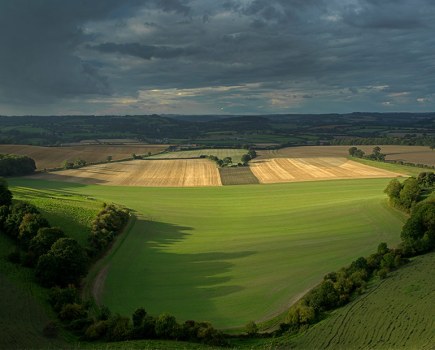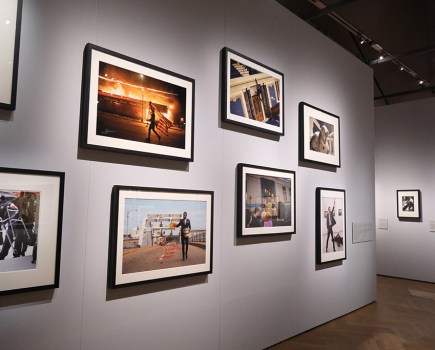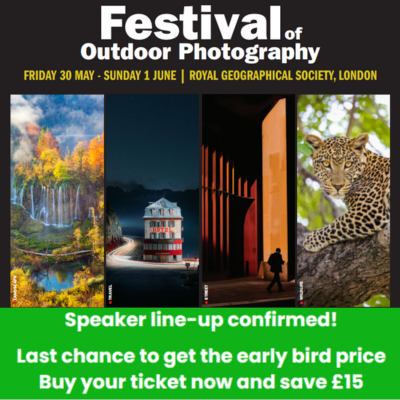
Newborn photography is usually done when baby is asleep. Credit: Kristina Mack. Model: Evie Deane Blakey
Ten years ago few considered newborn babies to be a major genre for photographers. Blotchy and wrinkled, they spend most of their time curled up asleep. Better to wait till they’re old enough to sit up and smile. But then, along came Instagram and celebrity photoshoots. Described by Vogue as a ‘distinctly millennial phenomenon’, newborn photography is a fast-growing field which photographers with their fingers on the pulse of social trends have been quick to capitalise on.
Kristina Mack of Essex-based Tiny Posers is one of those photographers. As well as running her own successful photo studio, she also holds workshops around the country for other aspiring newborn and maternity photographers, at which Kristina explains to her students the various ways in which newborn photography differs.
‘The first thing is that timing is very important with newborns,’ explains Kristina, ‘because they lose that womb-like curve after two weeks or so. Also they sleep a lot deeper in the first couple of weeks after birth, after which they become a lot more alert, which makes them more difficult to photograph. So I tend to schedule my newborn shoots for around 7-10 days after birth. That’s the best time.
It may seem counter-intuitive to want the baby to be asleep, but in this genre it is fundamental. You don’t really pose older children and adults; you direct them. But with newborns you literally mould them into the poses. You can’t just lay them down and get good pictures. A soundly sleeping baby can be moulded into a repertoire of poses while maintaining an expression of blissful contentment.
‘If a newborn baby is awake, then it’s seldom a happy baby,’ continues Kristina. ‘It will usually be because they’re hungry or windy or need a poo. You may have a few minutes of happy wakefulness but it won’t last long.’
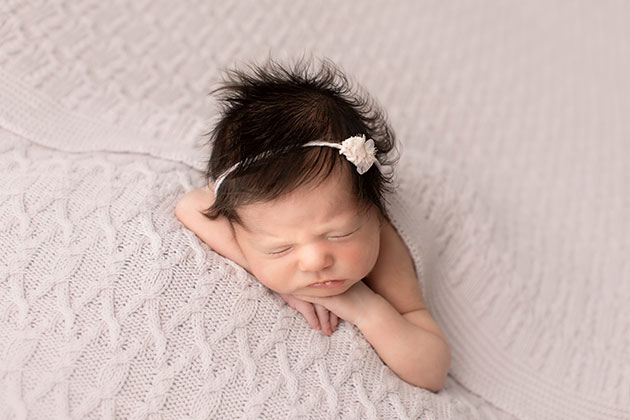
You need a healthy supply of sheets and blankets for newborn shoots. Credit: Kristina Mack
In order to stack the odds in favour of a successful shoot, preparation is key. ‘I ask the parents to try to keep their babies awake at least an hour before the session, and feed them just before they leave the house for the shoot. Most of my clients live within an hour’s drive of my studio, so by the time they get to me the baby is in a deep sleep and I can start working straight away. If I have clients coming from further away they can feed them when they get here. ‘I then work very quickly, and try to get as many pictures and as many poses as I can while they are asleep. I start very simple, with very little posing, and then I move baby little by little, transitioning gradually from one pose to another.
It sounds like newborn photography arguably has more in common with stop-frame animation than it does with other genres of portraiture. That and bomb disposal, because before she even starts shooting, Kristina has to very carefully extract the babies from the car seat they arrived in, undress them and place them on her beanbag – all without disturbing them. ‘In truth it is rare that the baby will not notice any of this at all,’ Kristina admits. ‘Usually they will wake up a little bit, so I swaddle them in the blanket and they usually go back to sleep.’
So what happens if they don’t go back to sleep? ‘Then we feed them and carry on going. But if you have to stop to feed baby during the shoot the session will take a lot longer because you have to allow for feeding time. So suddenly instead of the shoot being a couple of hours long you could be adding an extra hour or more. I always schedule my newborn sessions for first thing in the morning – around 9.30 or 10am, because they are a lot sleepier in the first half of the day, and I would never book another shoot earlier than 2pm. Most new parents aren’t yet fully confident with the baby so I try not to stress them by imposing a time limit.’
After taking some photos of the baby on its back, swaddled in a blanket, Kristina slowly removes the wrap, taking more pictures as she goes, and using different camera angles to create as many different images as possible. Then comes the higher-risk manoeuvre of turning the baby from its back onto its tummy.

Kristina keeps a good selection of bunnies to use as props in her shoots. Credit: Kristina Mack
‘I start with the legs out, then I tuck them into a more foetal position,’ she explains. ‘From here I have a few variations in the props and poses I use. I don’t do every pose with every baby – but depending on which way I’m going I may pick the baby up and use a basket or other prop, or I’ll just stick to the beanbag. I ask the parents if they have any cuddly toys they’d like to bring to the shoot, but I also have quite a big collection of bunnies.’
While the main focus of the shoot is the baby she also likes to involve the parents. ‘Usually I ask them to relax for most of the shoot but I may call them over to borrow their hands to use as props.’ One of her most popular shots is with baby curled up on the beanbag with the parents’ hands cupped around it as though the baby is suspended in the air. ‘It’s a shot they see on my website and often request, but they don’t even realise I’ve done it,’ she laughs. ‘They’ll ask: “Can we do that shot holding baby up?” and I’ll say I already did it, and then they look confused till I show them the picture on the screen. Of course baby’s safety is paramount – it wouldn’t be safe to hold the baby up in the air like that, so I do it on the beanbag, but the picture creates the illusion of that.’
Kristina stresses that every baby differs, and photographers shouldn’t adopt a one-size-fits-all approach to poses. ‘Some babies fall into a particular pose easily and some will not. Also two babies in the same pose can look very different. I always tell my students that if the baby is fighting it, or it doesn’t look right, try something else.’
At some point Kristina will switch to her macro lens and shoot some close-up detail shots, such as the baby’s fingers and toes. Most of the images of the parents holding the baby are done at the end, as it doesn’t matter so much if the baby is awake.

The parents’ hands surround the baby as it lies sleeping on the beanbag, making a strong graphic image. Credit: Kristina Mack
Kit and lighting
The shopping list of required kit for newborn photography is very small. Kristina shoots everything using just a standard 50mm prime lens, and a macro lens for the close-ups, and probably 90% of her shoots are lit entirely by natural daylight. She is lucky in that her studio is blessed with large windows, which she diffuses using sheer curtains. On very dark days she may resort to using her giant 1.5-metre wide Octobox softbox on a very low setting, which produces a similar soft light, but she tries to avoid it.
Kristina doesn’t need a huge amount of light anyway, since she always shoots fairly wide open. ‘I shoot mostly at f/2.8,’ she says. ‘and never go smaller than f/3.5.’ With such a shallow depth of field focusing can be tricky because newborn babies’ features are not so well-defined.
She positions baby with the head closest to the window, at about 45°, so the light falls off towards the feet. ‘The eye will always go to the brightest part of an image first – don’t let that be the baby’s bottom.’
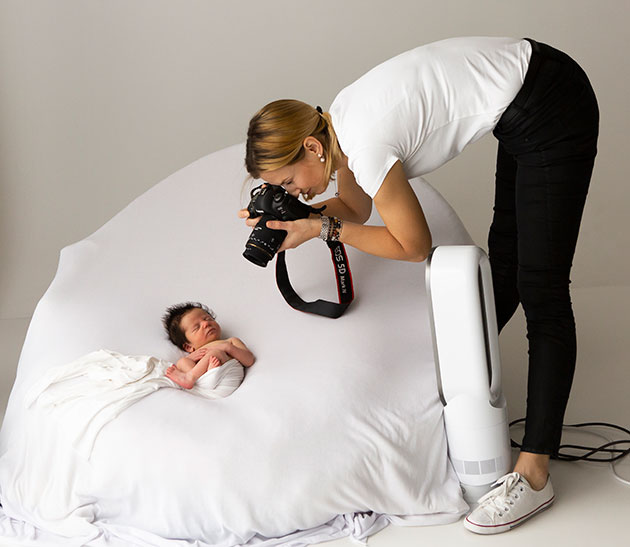
Kristina adjusting the baby’s pose on the beanbag. Credit: Kristina Mack
An important investment is in the props, and despite the small industry that has sprung up around selling props and fabrics specifically for newborn photography Kristina counsels against getting carried away. ‘You don’t need to buy a lot of props,’ she says. ‘In the beginning it’s tempting because you think: “If only I had that blanket, I’ll take amazing pictures.” But now I know it doesn’t matter what blanket you have. If you know how to pose and photograph the baby, you will have an amazing picture.’
Kristina shoots mostly on a beanbag, as you can mould it as you want, but does keep a good supply of cloths, towels and blankets to place under or around the baby to raise its head, for instance, and these may well need to be replaced during the shoot, as accidents can happen. ‘My washing machine and tumble dryer are on all the time,’ she admits.
For anyone tempted to get into this branch of photography Kristina stresses the importance of being confident around newborns. ‘Babies are like dogs – they can smell your fear,’ she laughs. ‘They need to be handled properly and held firmly to know that they are safe, and you need to know what to do if they become unsettled. When inexperienced photographers are starting with newborn photography and they tell me that a baby was bad, and cried the whole session, I say: “No – there are no bad babies. It’s because you didn’t know what you were doing.”’

Pictures of the baby with mum and dad are usually done at the end of the session. Credit: Kristina Mack
Kristina’s top tips
- Shoot in the first two weeks Babies lose their newborn look after about two weeks and become more alert. I like to shoot when baby is 7-10 days old.
- Keep the studio warm Babies can’t maintain their body temperature and will be naked for some of the time, so you need to work in a very warm room.
- Feed first The baby needs to be asleep for the duration of the shoot so make sure that they are fed immediately beforehand.
- Shoot in the mornings Newborns are a lot sleepier in the first half of the day, so I always schedule shoots for first thing in the morning, and allow lots of time in case they wake up.
- Work quickly I work quickly, shooting a lot of pictures and making small adjustments to the baby’s pose in between to avoid waking them.
- Use a beanbag A beanbag is the ideal backdrop to rest the baby on, as it can be moulded around the baby to keep them secure.
- Shoot details Parents love pictures of their newborn’s fingers and toes, and close-ups of their face.
- Soft natural light is best I prefer to shoot in natural daylight and so do my clients. Some parents specifically ask for flash not to be used. They worry that flash will somehow harm the baby even though that isn’t the case.
- Be confident Babies are like dogs – they can smell your fear. If you don’t have a steady hand they’ll be unsettled. You have to properly cuddle them so they can sense that they are safe.
- Don’t buy too many props It’s tempting to get carried away buying props and blankets, but it’s the pose and the way you photograph the baby that counts.
Posing ideas

Credit: Kristina Mack
Cupped hands
Shots like this and the one above are done with the baby lying on a black cloth and photographed from above, though it looks like the baby is suspended in the air.
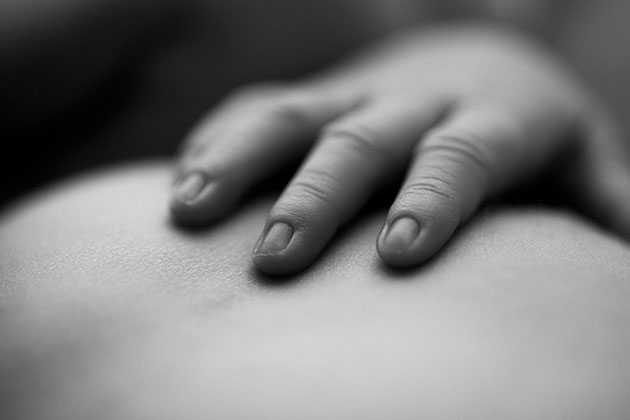
Credit: Kristina Mack
Fingers and toes
Kristina uses her Canon 50mm f/2.5mm macro lens to get close-up shallow-depth-of-field shots of baby’s fingers and toes. This was taken at f/2.8 at ISO 640.
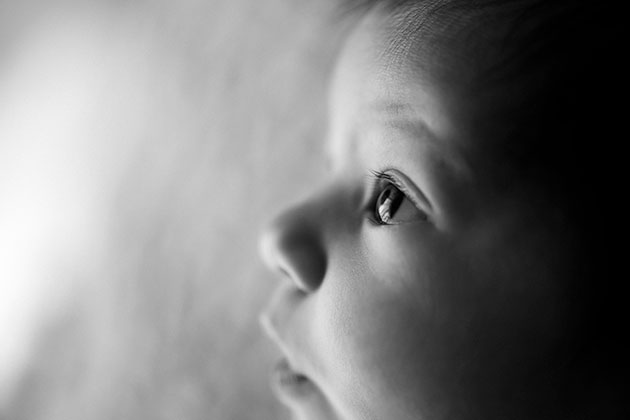
Credit: Kristina Mack
Details
Kristina often presents a collage of close-up detail shots, including the baby’s face, nose and ears. She produces a mixture of b&w and colour images from the shoot.
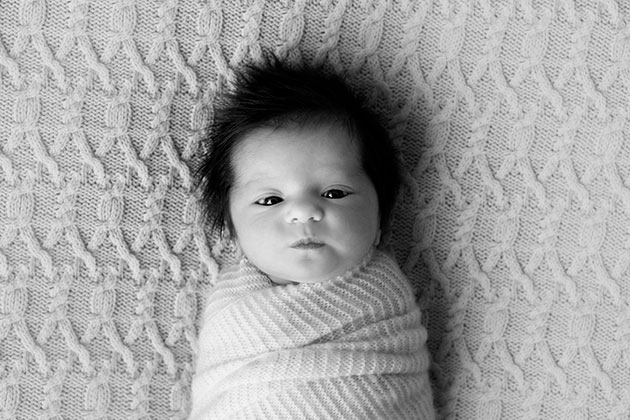
Credit: Kristina Mack
Swaddling
Newborns are calmed by being wrapped in a blanket, and are likely to go back to sleep fairly quickly after being removed from the car seat and clothes they arrived in.
Kit list
- Camera and lenses Kristina uses a Canon EOS 5D Mark IV with the Canon 50mm f/1.2L for most of her newborn photography, but switches to the Canon 50mm f/2.5 compact macro lens for the close-up shots.
- Beanbag and props Kristina uses a beanbag for her newborn shoots because you can mould the bag to whatever shape you want. She also has a selection of small towels, blankets and sheets of muslin to stuff underneath the baby to mould it or lift its head. A collection of bunnies adds a final touch.
- Lighting Kristina prefers to shoot in natural light using her big windows, and her clients often request it, but for dark days she has a Bowens Octobox 150, which is a 1.5-metre diameter softbox that does a good job of emulating natural daylight.





